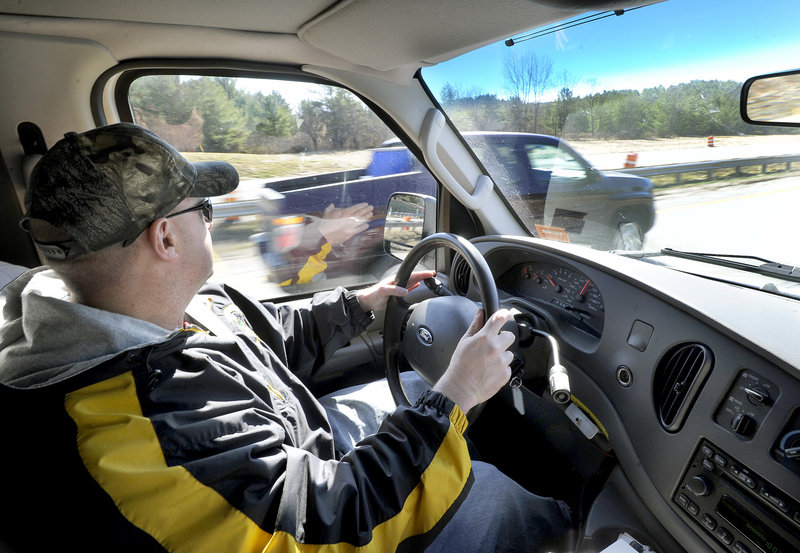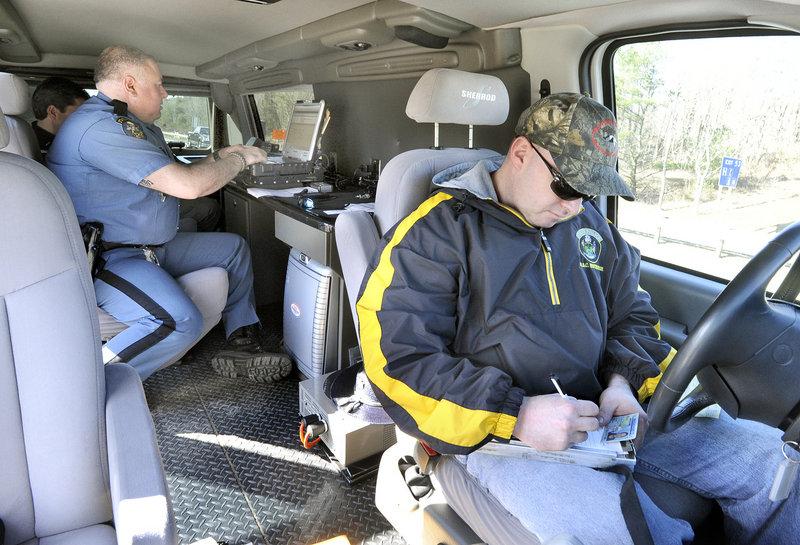Maine State Police Trooper Michael Cook peers out the side window of a nondescript van rolling along the Maine Turnpike during Thursday morning’s commute.
He’s scanning passing cars, looking for drivers who are texting on cellphones or doing anything else that distracts them as they drive.
A red pickup truck passes the unmarked police van. The driver has a cellphone perched between his hands on top of the steering wheel, his thumbs working the keys. Trooper Steven Stubbs, at the wheel of the van, pulls in behind the pickup and turns on the blue lights.
The teenage driver starts to pull to the left, into the median, but Stubbs motions him to head for the breakdown lane.
The 18-year-old is apologetic. He tells Cook that, on his way to school, a girl texted him, asking to meet between classes. The rendezvous will cost him $100, under a law that took effect in September to make it illegal to text and drive.
Police have seen the deadly results of texting and driving.
This month, a 44-year-old woman from West Enfield was texting moments before she crashed her car into a tree and died. And in January, an 18-year-old driver was texting before she lost control on a patch of ice and crashed in West Paris. Two of her teenage passengers were killed.
The law and its enforcement are designed to get people to put down the phone and focus on their driving. But it can be hard for police in marked cruisers to catch people in the act.
Officers don’t have the equivalent of radar to determine whether someone is texting. They can examine a phone after a crash, to see if texts were sent or received in the seconds before impact.
Last month, police tried out the unmarked van, which has been used over the years for speed traps, and found it worked well for distracted-driving enforcement. Police summoned 23 people to court for distracted driving, three of them for texting.
One woman who was cited appeared to be driving drunk — drifting from one side of the highway to the other, at one point kicking up dirt in the breakdown lane. The troopers saw from the van that the woman was punching at the keys of her cellphone.
On Thursday, Stubbs drove the van wearing a camouflage baseball cap, mirrored sunglasses and a black-and-yellow windbreaker. Cook was in uniform but couldn’t be seen from outside because of the privacy glass of the van windows.
Troopers spend the morning patrolling the busy stretch of the turnpike between the Falmouth spur and Biddeford. Through Portland, there’s heavy traffic and many interchanges so most drivers are paying attention.
Few people are spotted texting and driving. The more common infraction is talking on the cellphone while speeding or driving aggressively.
Stubbs spots a man in a beige Honda sedan, talking on a cellphone and driving almost 80 mph until he slows abruptly just a foot or two from the car in front of him. He keeps tailgating in an apparent effort to get the driver in front of him to pull over, then shifts to the center lane without signaling.
Stubbs turns on the blue lights.
“That’s a good stop, because he’s definitely being unsafe — right on that guy’s bumper, he’s going 80 miles an hour and he’s changing lanes without signaling,” Stubbs says.
Talking on the cellphone isn’t a violation in itself. But if someone is on their phone and ignoring traffic laws at the same time, the law says that police can conclude the person is driving distracted.
Cook gives the man his ticket.
“He was actually very good about it,” Cook says. “He said, ‘That’s a very expensive phone call.’ “
A driver can be ticketed for doing anything that impairs his or her ability to drive safely, and police have seen a lot of those things. People put on make-up or read a book while they drive. Even fishing out a breakfast sandwich can cause a driver to drift into another lane.
Texting, which is now a reflex activity for many people, earned its own law because it is particularly distracting.
Resuming the patrol, Stubbs sees a Chevrolet Silverado coming up fast in his side mirror and sees the driver eating what turns out to be a Subway sandwich.
“He’s doing 80,” Stubbs says.
Cook approaches the passenger window and finds three men on their way to work.
“His first comment was, ‘Sorry, I wasn’t paying attention,’ ” Cook says after engaging the driver to get his license and registration.
Stubbs writes out the ticket while Cook checks to make sure the driver’s license isn’t suspended.
“I’ll write it for 74 mph,” says Stubbs, without a radar gun to pinpoint the speed. “It will save him a bunch of money and grief and points.”
The driver also gets the distracted-driving citation and a warning for failing to use a turn signal when changing lanes.
Next, the driver of a silver Quest van appears to be alternately looking at his phone and speaking on it, drifting from one side of his lane to the other, despite heavy traffic.
After getting pulled over, the driver says he was looking at a picture of an ailing relative on his phone, and praying for them.
Cook says he is not insensitive to the man’s grief, but his driving was unsafe and if he crashed into a van full of kids, there would be a lot more grief.
In all, the distracted-driving detail issued citations to 10 drivers in about two hours, two of them for texting and the rest for driving distracted.
“That sends a message,” said Steve McCausland, spokesman for the Department of Public Safety. “Your first priority behind the wheel is to drive.”
Staff Writer David Hench can be contacted at 791-6327 or at:
dhench@pressherald.com
Send questions/comments to the editors.




Success. Please wait for the page to reload. If the page does not reload within 5 seconds, please refresh the page.
Enter your email and password to access comments.
Hi, to comment on stories you must . This profile is in addition to your subscription and website login.
Already have a commenting profile? .
Invalid username/password.
Please check your email to confirm and complete your registration.
Only subscribers are eligible to post comments. Please subscribe or login first for digital access. Here’s why.
Use the form below to reset your password. When you've submitted your account email, we will send an email with a reset code.